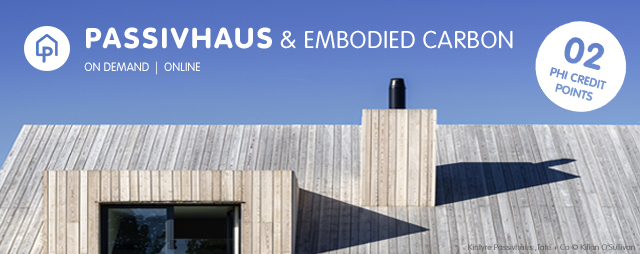
Radically reducing operational energy is what the Passivhaus standard does well, but what about embodied carbon?
Explore the relationship between Passivhaus and embodied carbon. Get access to the on-demand recording of the popular webinar to learn more about the Trust’s Embodied Carbon paper, followed by engaging presentations from key experts. It is an excellent opportunity to learn first-hand from industry practitioners as they share real-life case studies and valuable lessons learnt.
PHI Credit Renewal Points available: Delegates will earn 2 PHI credit points towards renewal of their Certified Passivhaus Designer / Consultant qualification. See here.
Speakers

By the end of this module you will be able to understand:
- The UK context for embodied carbon in the built environment.
- Operational and embodied carbon and their relationship throughout a building’s life cycle.
- Passivhaus buildings offer an optimal approach to minimising whole life carbon emissions.
- Why operational emissions should be reduced.
- How carbon emissions in buildings can be reduced through the circular economy.
- The carbon payback of different window frame and glazing types.
- The case for larger‐scale EnerPHit refurbishment.
- How evidence‐based and whole life carbon engineering as a means to justify such projects.
- The use of PHribbon tool, for evaluating and optimizing the carbon performance.
Course Content
Explore the relationship between Passivhaus and embodied carbon. Get access to the on-demand recording of the popular webinar to learn more about the Trust's Embodied Carbon paper, followed by engaging presentations from key experts. It is an excellent opportunity to learn first-hand from industry practitioners as they share real-life case studies and valuable lessons learnt.
First delivered on: 25 May 2022Speakers
- Introduction - Sarah Lewis, Passivhaus Trust
- Passivhaus Trust Embodied Carbon Paper - Rachel Mitchell, Passivhaus Trust
- Embodied Carbon New Build: windows - Mark Siddall, PHT member LEAP
- Embodied Carbon Retrofit: St. Sophia’s Primary School - James Parker, Expedition Engineering & Useful Simple Trust
- PHribbon - PHT member Tim Martel
- Q&A
Learning outcomes
By the end of this module you will be able to understand:
- The UK context for embodied carbon in the built environment.
- Operational and embodied carbon and their relationship throughout a building’s life cycle.
- Passivhaus buildings offer an optimal approach to minimising whole life carbon emissions.
- Why operational emissions should be reduced.
- How carbon emissions in buildings can be reduced through the circular economy.
- The carbon payback of different window frame and glazing types.
- The case for larger‐scale EnerPHit refurbishment.
- How evidence‐based and whole life carbon engineering as a means to justify such projects.
- The use of PHribbon tool, for evaluating and optimizing the carbon performance.